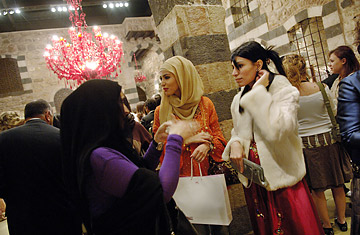
Guests gather around for the opening party for luxury boutique Villa Moda's branch in Damascus.
Give or take a few Inshallahs, the sound track inside the glass conference room at a far-flung MTV affiliate in Dubai one recent morning was pretty familiar. As several young television producers filed into the room, chitchat turned to coffee orders, music preferences and fashion. "Check out Wesam, man. Is that Lomar? That script is hot."
This was no hipster haiku between a cool T shirt and a pair of customized jeans. Instead, playing out across the table was a magnificently absurd Fashion Moment: two young guys in identical Middle Eastern white robes critiquing a third guy's robe.
The routine had YouTube potential. Maybe they were spoofing colleagues at the music channel, most of whom were wearing trendy jeans and T shirts. These might be the same pranksters who had taped a crime-scene-style outline of a dead body under the reverential oil paintings of the ruling sheiks downstairs. ("That's Sam—he got promoted," a woman walking by had explained, nodding at the tape.)
On closer inspection, one white thobe, as the traditional long men's robe worn in Dubai and other gulf states is known, looked crisper than the others. Cut closer to the body, it was more tunic than caftan, and there was a subtle tone-on-tone embroidery in Arabic script on the lapel. With a Diesel watch and highlighted hair, Wesam Kattan, 27, the Saudi brand manager at the music channel, looked as if he had bypassed the Hugo Boss and Prada suits hanging in his closet that morning, opting instead for Middle Eastern mod.
Kattan is in excellent company. Across the region, where about half the population in key markets is under 25, fashion-loving teenagers and twentysomethings are fixated on traditional garments like the thobe and the women's long, black abaya and head scarf—but only once they've been souped up to reflect the wearers' personal style. Chic schoolgirls in Dubai snub abaya stores at the mall and order full-length robes from tailors who specialize in more fitted cuts with bold butterfly appliqués and floral embroideries. (Underneath, of course, they're wearing the same jeans and tops as their peers in Europe). Abayas with kimono sleeves lined in bright silks and studded with Swarovski crystals are also popular. Even fashion's biggest names are weighing in on the craze. At Villa Moda's Kuwait City store beginning in May, clients can special-order retooled dishdasha robes, head scarves and abayas from Western designers like Tom Ford, Dries Van Noten and Jil Sander.
"Some people see the abaya as oppressive. I wear it by choice," says Sidiqa Sohail, 17, a senior at a private girls' school in Dubai, as she and her best friend, Rawaa Talass, scout stores at Dubai's Mall of the Emirates. "It's so funky, don't you think?" Sohail is showing off her full black sleeve, trimmed with a river of subtle garnet beading. She stops and flips her matching head scarf. "Dalo'oua," she giggles. Talass laughs and translates the slang for spoiled brat. Talass is wearing a sleeveless top and pants and says she never wears the abaya or covers her head. At school it's the same thing; some girls do, others don't. But both narrow their eyes warily as a wild-looking group of girls strolls past in garish tops and accessories with their standard-issue abayas worn open over tight-fitting jeans.